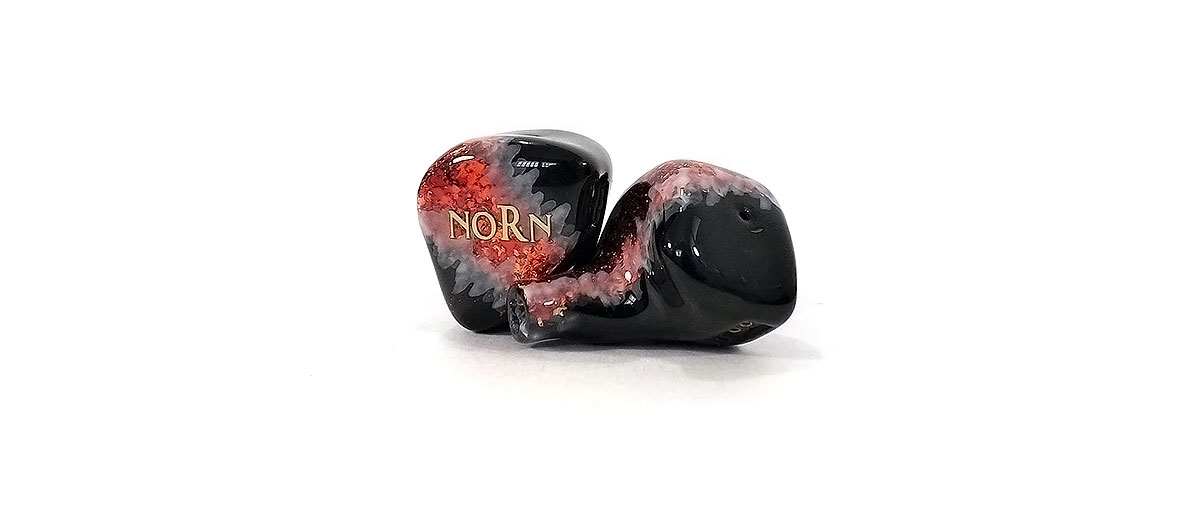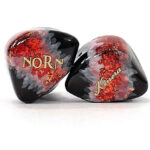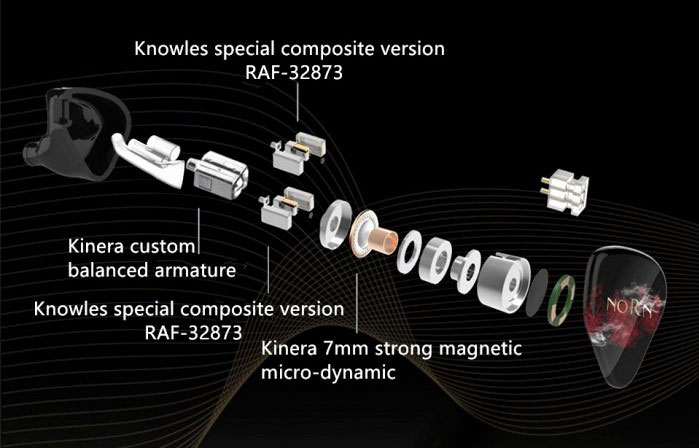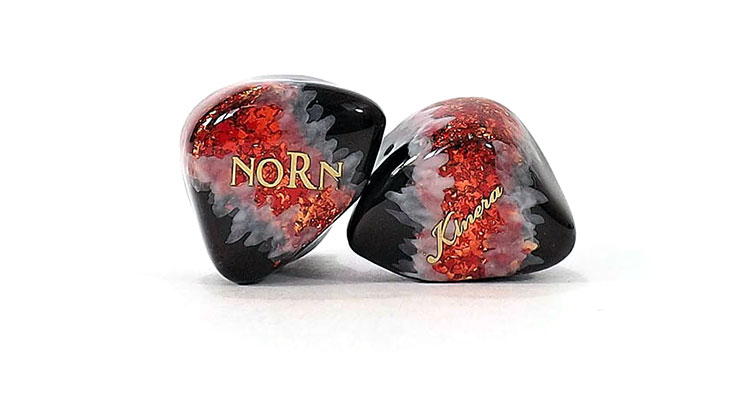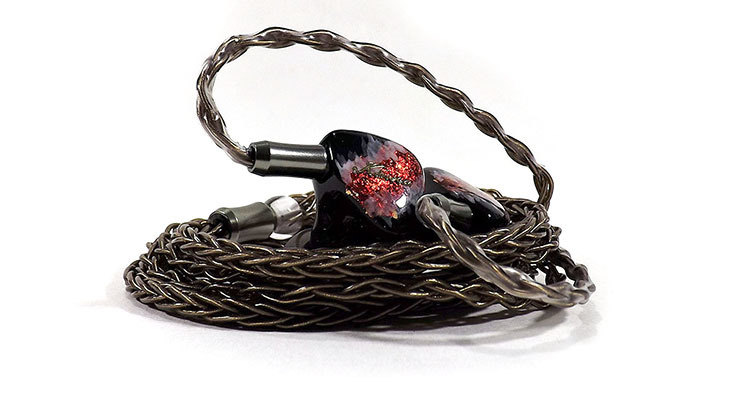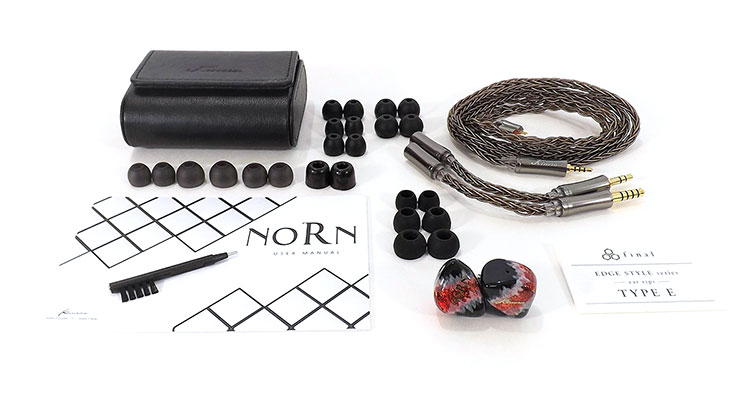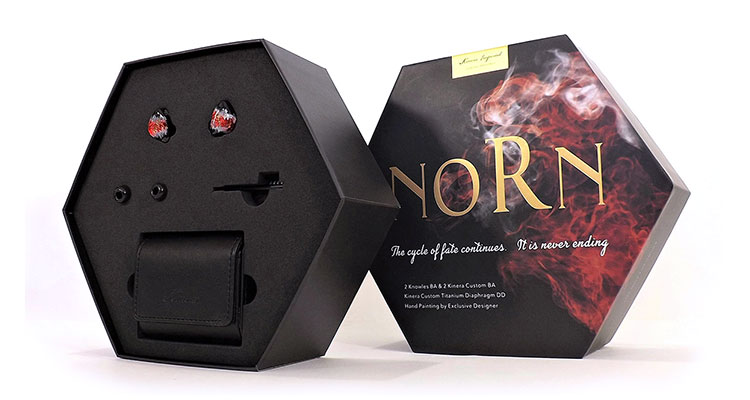The Kinera Norn is the company’s latest hybrid universal monitor featuring a single titanium-plated dynamic driver and a quad-BA design. It is priced at $509.
Disclaimer: The Kinera Norn was sent to us a sample in exchange for our honest opinion in this review. We thank the team at Kinera and HifiGo for giving us this opportunity.
To read more on Kinera products we have reviewed on Headfonics click here.
Note, this review follows our new scoring guidelines for 2021 which you can read up on here.
Kinera is a company that blends art with sound and conceptualizes mythology with modern tech. What does that all mean to the average IEM buyer? They know how to make some good-sounding and beautiful-looking IEMs.
Actually, Kinera only makes IEMs with the exception of one TWS model they offer which is identified as the YH623. Their entire line consists of ten models that start with a very basic model which is the no-frills TYR up to a top tier 1400 dollar model which is the Baldr.
Somewhere in the middle sits the Kinera Norn which is a hybrid IEM promising superb acoustic performance. Let’s see if this Maiden can twine the thread of fate.
Tech Highlights
Configuration
The Kinera Norn internal components consist of a five-driver array in a somewhat common configuration. A dynamic driver handles the lows while four balanced armatures handle the rest. The drivers are used in a 1+2+2 configuration.
The bass is handled by a Kinera custom micro-dynamic 7mm Titanium plated PU composite high poly-fiber diaphragm driver with an N52 strong ring magnet and a 1.5 Tesla magnetic flux rating. Driving the diaphragm is an imported Japanese-made Daikoku pure copper voice coil.
The midrange response comes from two Knowles Balanced armatures while two other Kinera customized Balanced Armatures handle the high frequencies.
Three Tube System
There is no mention of what internal components make up the electronic crossover or if there is any within the literature of the Kinera Norn except for a 3 tube system. Looking at the exploded view gives no clue either. Perhaps each driver has its own filters.
Within the shells of the Kinera Norn IEMs is what Kinera calls a 3 tube front cavity crossover which in theory removes multi-driver sound wave internal collisions and right at the ear canal entry-level.
Another good characteristic from this 3 tube design besides collision canceling is by playing with different tube lengths and by that tuning method, Kinera can obtain a better in phase sound at the ear.
A sound wave collision is when two sounds meet and in certain cases, produce extra frequencies, anomalies, or can also cancel frequencies out and sounds can become out of phase and this design Kinera claim takes care of that.
The result is a three output nozzle that sends each driver’s output directly to the tip of the output nozzle so each driver’s output reaches the ear canal directly and at the same time with a minimal amount of phase anomalies or frequency altering collisions.
Design
Reflective Back Cavity
Kinera claims in their literature that the Norn has a back piece with a mirror finish back cavity and it is unclear if this is a sound improvement feature or if they are just talking about the reflective finish of the backplate artwork design.
There is mention of a reduction in sound loss and delays thanks to a diffuser reflector on the back panel. Some manufacturers are shy with specifications and descriptions and here is an example.
The Kinera Norn shells seem to be made of medical-grade resin because my ears tend to be sensitive to any type of material that is irritating and these were comfortable to me and never caused any itchiness.
I think these shells are gorgeous and I like the design, color scheme and their construction seem robust enough to last many years. I do prefer when the output stem is part of the shell structure like in this particular shell because metal shafts glued to a shell sometimes give me a sense of insecurity especially when swapping rubber tips which I do often.
Stock Cable
I really like the cable assembly that comes in the box with the Kinera Norn and not only does it look good but also seems well constructed and made with quality parts with lots of attention to detail.
The main cable is an 8 wire braid with PVC outer insulation. Each wire core is a 26 gauge 24 strand silver-plated copper with a total strand count of 192 if you count all the strands.
The best part of the wire is the 3 connection types possible due to the two included adapters approximately four inches long that are made to perfectly match the main cable hardware.
Connections
The three connections possible that come inside the box with the Kinera Norn are the basic 3.5mm TRS single-ended and a Pentaconn 4.4mm TRRRS by use of the included adapters. The main cable assembly is terminated in a 2.5mm TRRS balanced plug.
All the hardware connectors are metal with a glossy finish tinted in Mocha-like color with gold accents except for the Y length adjuster which is made of clear plastic. All the hardware is branded with the Kinera logo name.
Moving up the cable up to the earbuds, the connections terminate in 0.78mm 2-pin male connectors which go into the IEMs surface-mounted connector on the IEM body making a pretty secure connection.
Packaging & Accessories
Kinera threw me a curveball here because when I looked inside the Hexagonal shaped product box I found a series of ear tips and a booklet from Final Audio. That’s because the Norn comes with 6 pairs of Final Audio type E ear tips besides 6 other rubber tip sets and a single pair of foam tips. I found the Final Audio tip inclusion interesting.
I do find it a bit disappointing that the Kinera Norn only come with just one set of foam tips because for me they worked best and gave me the cleanest bass response, a closer to neutral signature, and the high frequencies were soothed over compared to rubber tips. That however is my personal opinion and you might like the other tips more.
Another curveball was to read on their website that they include only 6 ear tip sets and one foam set when in fact I got 12 sets in total so they undercut themselves on what comes in the box. They seemed to not list all the accessories for some reason. Generous comes to mind.
The Faux leather carrying case seems robust and looks elegant with an embossed Kinera name on the opening flap which has a magnetic lock to keep the contents in place and securely closed. What else is in that box? A user’s manual, a Final ear tip booklet, and an eyebrow brush. Or is it?
Sound Impressions
Tonality
The Kinera Norn has a dynamic tonality with a small dip in the midrange and a general character that seems slightly U-shaped with a 10-decibel spread from bottom to top according to Kinera Audio’s graph dipping the furthest in the midrange and to my ears, the graph seems somewhat right.
Bass response is punchy and quick responding with a likable amount of bass presence typical of Tesla rated magnet driver assembles with Japanese coils. The bass has omnipresence and at the same time can place bass notes where they belong.
The midbass is the most prominent part and the lower portion is a few decibels south for my ear’s preference but I did 2 decibels up at 77 Hz and 3 at 55 Hz on Foobar and the bass fell in what I would consider an ideal place in output for my taste.
Midrange response is smooth and sweet-sounding and the most relaxed section of the frequency spectrum and seems polite and somewhat expansive with a good tonal balance. Notes occupy a nice space within the stage and remain well organized. Elements are well isolated and fairly controlled.
The high-frequency response might be too sharp for some and a tad forward. There is a peaky area around 7 kHz and once again graphs prove nothing because that peak is not shown, contrary, that region seems rather flat on the graph.
Once I tamed that 7 kHz dropping the EQ 3 decibels in that area, the Kinera Norn fell in place and produced some fairly realistic cymbals, crashes, and performed well with great extension, good airiness, and well-placed highs although on the intense side of the line.
Staging
I must admit, this area is where I like the Kinera Norn the best because they can 3D image well by positioning elements front to back well but also combine height and depth producing a believable stage.
I love how these IEMs can image drums, especially their ability to place those sticks where the producer wanted them to be. Keeping up with the same subject matter, since the Norn has a fairly dynamic signature they tend to makes drum sounds shine.
Morning Sprite by the Maestro and late Chick Corea has a drum solo at the third-quarter end and if you listen to that particular solo on the Norn you will get fast attacks with great dynamics. The thump and all the way to the crash sound realistic. But most of all each tap is where it’s supposed to be.
The Kinera Norn also has the ability, at least to my ears to drop sounds almost below the chin level while also giving off some rear reverb character. The stage is fairly large but remains mostly within the recording parameters which are ideal for realism.
Musicality
The Kinera Norn does detail well and does a fairly good job at bringing out the nuances of tracks and bringing them more upfront.
Simple tracks like Writing from Elton John which might be an overlooked track until you hear it on good IEMs like the Kinera Norn and realize there are more elements in the track than you thought and all the combined nuances that come out like double rhythm strings and similar thing like that make the recording sound quite interesting.
So it is also safe to say that the Norn can produce detail and nuances and is no slouch at that but does not become incoherent either when a track becomes complex.
I threw in Man from Uncle OST the Drums of War track which on most IEMs sounds incoherent, congested, and confusing but on the Kinera Norn everything was in its place, and every drum had its own space within the track. After listening to this track I knew these can handle complex compositions.
Using the Kinera Norn you could hear lots of detail with a good stage and these two facts make them a good listen besides having a good tonal balance except for the lower treble which is somewhat edgy. The peaky area gives a forward impression.
Synergy
If you can, try to feed the Kinera Norn with a warm-sounding amplifier. It might help quell those edges in the higher frequencies. My pair particular pair liked the iFi iDSD Signature with the Xbass on of course and I bet they would sound great on tubes.
I would say these are highly efficient because they produced ample volume levels with my phone and some amplifiers with a varied amount of power starting at 8mw per side like the Hidizs H2 all the way to over 7 watts per channel and a bunch of micro DACs in between.
Since these come with those adapters that change the plug gender, I was able to use this setup with any player I had and never had problems with any device I used.
Select Comparisons
AYA Siren
Technical
The AYA Siren is a totally different IEM in many ways except for the price. They cost almost the same as the Norn but are very different in construction, especially in sound characteristics.
The AYA Sirens are constructed more traditionally with a resin shell and a decorative backplate, in this case, made of wood instead of finished off with artwork. The venting tube is aluminum and as previously stated, when it’s part of the shell structure it tends to be sturdier for those who often swap tips.
Both come with decent cable assemblies but the Norn has the edge by including 2 adapters giving you three different connection options. Another area that the Norn pulls ahead is accessories, including more tips and a more elegant carrying case versus the pelican case included with the Sirens.
Sound
I would say these are opposites and contrast each other. I like the Kinera Norn from the bottom to the top with the highs being my least favorite section while on the AYA Sirens that fact is opposite and I like the highs the best and from top to bottom.
The bass is more impactful and robust with the Norn but all the rest is best described as smooth in the midsection while the highs are sharp and well extended with a prominent 7k peak which makes them sound forward in that area.
The AYA Sirens take the high frequencies to the edge but somehow remain within an enjoyable range with less bothersome peaks. The midrange is somewhat similarly tuned but the bass improves on the Norn because of the use of BA bass drivers on the AYA Sirens.
I must admit I’m not a fan of BA bass and find the Norn bass more to my taste but noted, the bass response on the Sirens was one of the best BA bass capable IEMs probably because of its dual BA bass driver configuration.
Unique Melody 3DT
Technical
This IEM has more contrasting features than the first in many ways starting from the body construction which is completely made of wood and the only common trait they share are the .78mm connectors.
The wire is lackluster compared to the stock Norn wire but I guess that is where part of the price difference is. Another accessory that clashes with contrast are the cases each IEM includes. UM is unique in the fact that their included carrying case resembles a miniature beach bag and that is unique. Things like this give meaning to their unique name.
Sound
I broke these out when I heard the Norn because of their similar tonality and sound signature. One thing that needs to be mentioned is that the UM 3DT has a steeper u shaped curve which has a 20-decibel difference tip to tip instead of a 10-decibel spread.
Bothe these IEMs have very good bass that is snappy, fast, and punchy which transitions into the midrange smoothly and remain so until they reach the upper regions.
The UM 3DT dips early in the high-frequency region above 8kHz while the Kinera Norn extends well beyond my hearing but had an aggressive area around 7khz that some might not like and might find the Norn to be excessively bright and forward in that region.
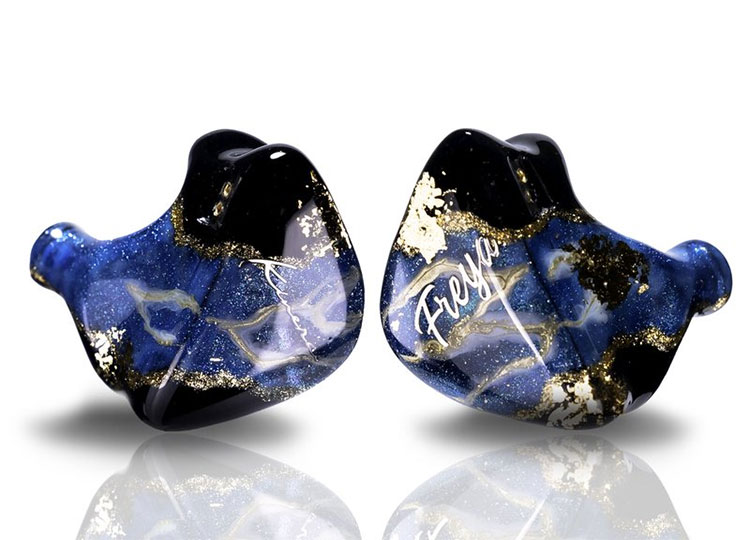
Kinera Freya
Technical
For some reason, Kinera decided to reduce the number of accessories when I compared the Norn to their own Freya IEM that costs less. However, the Freya has some accessories that might not be useful to some so they live in the box forever.
I do prefer having better connectivity in the form of the balanced connectors over USB-C to 3.5mm adapters for example. Other accessories are similar including the eyebrow brush and even the box is similarly shaped. Is there a refinement in the overall presentation? Yes but not really in appearance, just in the type of accessories and sound.
Both IEMs do have the same Unibody construction that has the output ports that integrate as part of the shell and not a shaft glued to the shell end. Both these IEMs are gorgeously done so it’s a matter of personal preference here.
Sound
Did Kinera put these two models in a good price range and are there refinements especially in the sound? Of course, there are but it’s more complex.
The Freya does have a more relaxed tone with highs that for one do not have peaky areas that become bothersome so some people might like that over the intensity of the Norn. But that has caveats.
The problem is that since the Freya loses the high-frequency extension it therefore also loses micro detail and you tend to miss out on some nuances. So it’s safe to say that this is where the extra money goes to. Not only that, but the Norn improves on the soundstage giving you a couple of extra dimensions and some more depth.
Our Verdict
The Kinera Norn is a beautiful looking IEM with a well-constructed cable assembly with 3 different connection possibilities which always adds value to an IEM.
My only aversion is the lower treble and the forwardness of the 7 kHz area and if wasn’t for that, sonically these would be almost perfect because they do show off recordings well by producing a high level of detail with a great soundstage and great 3D capabilities.
Who would like these? Potential buyers, who are looking for a comfortable IEM with clean bass that can dig deep, smooth midrange, and a somewhat forward treble response that extends well. But to me what these do best in detail and soundstage although their tonality is not bad either so if that’s your bag, here it is.
Kinera Norn Specifications
- Impedance 32 ohms
- Sensitivity 110db
- Rated Power Distortion less than 3%
- Frequency Response 5Hz to 40kHz
- Cable Length 2m
- Plug 5mm Balanced

